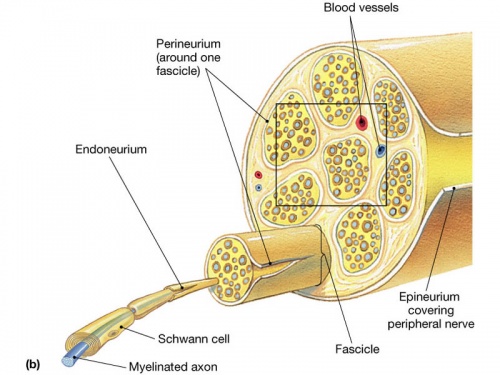Classification of Peripheral Nerve Injury
Original Editor - Tomer Yona
Top Contributors - Tomer Yona, Emma Sewell, Jayati Mehta, Kaylee Byars, Katherine Baca, Kim Jackson, Naomi O'Reilly, Claire Knott, Lucinda hampton and Matt Huey
Description[edit | edit source]
Peripheral nerves are responsible for somatic (voluntary) and autonomic (involuntary) functions. The primary functions of the peripheral nervous system are to receive general sensations (touch, pressure, temperature, and pain), and special sensations (sight, smell, taste, and hearing), integrate sensory input from the entire body, and generate a response[1]. Peripheral Nerve Injury can be sustained from traumatic or idiopathic mechanisms. Individuals with diagnoses of diabetes, alcoholism, vascular disease, autoimmune diseases, or who have been exposed to chemotherapy drugs or infections that attack nerves have a higher likelihood of acquired peripheral neuropathy[2]. The severity of peripheral nerve injury is determined with advanced imaging (CT, MRI, or MRI neurography) or nerve conduction velocity testing and classified using the Sunderland classification system[2]. Treatment of peripheral nerve damage depends on the severity of the damage and may include surgical procedures, skilled physical therapy, orthotics, or medications[3] .There are three basic types of peripheral nerve injuries (PNI) commonly seen in the clinic: stretch related, lacerations, and compressions[4].
Stretch Related[edit | edit source]
The peripheral nerves are elastic, but when a traction force is too strong injury occurs. If the Traction force is strong enough, a complete tear may occur, but most commonly the continuity is retained, resulting in injuries such as Erb's Palsy.
Lacerations[edit | edit source]
Another common type of PNI are lacerations created by blades. those types of injuries might be complete transections- but most commonly some continuity remains.
Compressions[edit | edit source]
The third type of PNI are compression These injuries include the Saturday Night palsy due to radial nerve compression as well as entrapment neuropathies and do not involve tearing of the neural elements[4].
The most common of the three is stretch-related, followed by lacerations and compression[5].
Classification[edit | edit source]
There are two commonly used classification for PNI- the Seddon Classification and the Sunderland Classification.
Seddon classified nerve injuries into three major groups: neurapraxia, axonotmesis, and neurotmesis whereas Sunderland expanded Seddon's Classification to five degrees of peripheral nerve injury as described in the table below: [5] [6]
| Seddon | Process | Sunderland |
| Neurapraxia | Local myelin damage usually secondary to compression | First degree |
| Axonotmesis | Axon severed but endoneurium intact (optimal circumstances for regeneration) | Second degree |
| Axonotmesis | Axon discontinuity, endoneurial tube discontinuity, perineurium and fascicular arrangement preserved | Third degree |
| Axonotmesis | Loss of continuity of axons, endoneurial tubes, perineurium and fasciculi; epineurium intact | Fourth degree |
| Neurotmesis | Complete physiologic disruption of entire nerve trunk | Fifth degree |
Nerve Anatomy[edit | edit source]
For a great information source for Physiotherapy following nerve injury see Nerve Injury Rehabilitation Physiotherapy
Resources[edit | edit source]
- http://www.gms-books.de/node/638
- http://www.scielo.br/scielo.php?script=sci_arttext&pid=S0004-282X2013001100811
References[edit | edit source]
- ↑ Radhakrishnan, R. What are the 4 main functions of the nervous system? Available from https://www.medicinenet.com/4_main_functions_of_the_nervous_system/article.htm (Accessed 18 March 2023).
- ↑ 2.0 2.1 National Institute of Neurological Disorders and Stroke. Peripheral neuropathy. Available from https://www.ninds.nih.gov/health-information/disorders/peripheral-neuropathy (Accessed 18 May 2023).
- ↑ Johns Hopkins Medicine. Peripheral Nerve Injury. Available from https://www.hopkinsmedicine.org/health/conditions-and-diseases/peripheral-nerve-injury (Accessed 18 March 2023).
- ↑ 4.0 4.1 Burnett MG, Zager EL. Pathophysiology of peripheral nerve injury: a brief review. Neurosurgical focus. 2004 May;16(5):1-7.
- ↑ 5.0 5.1 Campbell WW. Evaluation and management of peripheral nerve injury. Clinical neurophysiology. 2008 Sep 30;119(9):1951-65.
- ↑ Lee SK, Wolfe SW. Peripheral nerve injury and repair. Journal of the American Academy of Orthopaedic Surgeons. 2000 Jul 1;8(4):243-52.
- ↑ http://www.gms-books.de/book/living-textbook-hand-surgery/chapter/nerve-injury-classification-clinical-assessment
- ↑ nerve damage and regeneration








